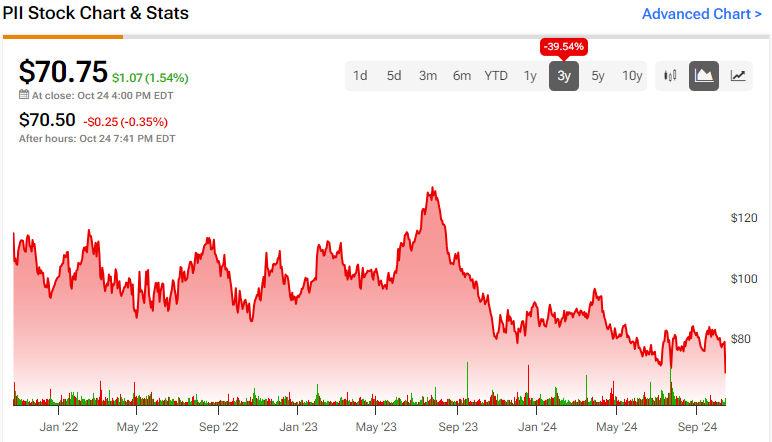Amid a challenging economic climate due to high inflation and interest rates, Polaris Industries (PII), a leading powersports vehicle manufacturer, has experienced a downturn. Its stock has declined roughly 40% over the last three years. However, with easing inflation, there were expectations that the company would start to bounce back. Unfortunately, the company seems to be headed in the wrong direction. Q3 sales saw top- and bottom-line misses, punctuated by a lackluster forecast from management for Q4. Investors may want to stay on the sidelines until the company can demonstrate material improvement.
Confident Investing Starts Here:
- Quickly and easily unpack a company's performance with TipRanks' new KPI Data for smart investment decisions
- Receive undervalued, market resilient stocks straight to you inbox with TipRanks' Smart Value Newsletter

Polaris Trying to Keep Its Network Intact
Polaris is a leading manufacturer and marketer of powersports vehicles. They provide off-road vehicles (ORVs), military and commercial ORVs, snowmobiles, motorcycles, quadricycles, boats, light-duty hauling, and passenger vehicles. Their accessories range includes ORV accessories, snowmobile accessories, motorcycle accessories, and a diverse range of gear and apparel. Products are available through dealers and distributors, as well as online marketplaces.
Due to the challenging macroeconomic environment, the company has recently taken strategic steps to protect its dealer network. This resulted in a decrease in sales by 23% due to a deliberate reduction in production and shipments. Despite the short-term negative impact on results, these measures were deemed necessary to uphold Polaris’s commitment to its dealers and aim to reduce dealer inventory.
Polaris has successfully reduced dealer inventory below the beginning-of-the-year levels. However, due to the lower-than-expected retail performance in Q3 and throughout the year, shipment expectations have been lowered to support their goal of reducing ORV dealer inventory by 15-20%, indicating further retail declines ahead.
Analysis of Polaris’ Recent Financial Results & Outlook
The company recently reported a disappointing Q3 performance, with revenue of $1.72 billion showing a decline of 23.6% year-on-year and falling short of analyst estimates by $50 million. The downturn in earnings was driven by a 7% drop in powersports retail sales compared to the previous year, with ORV, Motorcycle, and Marine sectors registering declines; ORV retail alone dropped by 3%. Non-GAAP earnings per share (EPS) of $0.73 missed consensus projections by $0.18.
Management has revised its financial guidance downward for the entire year of 2024. Initially predicted to be down between 17 and 20% relative to 2023, the company’s sales outlook now anticipates an approximately 20% decrease. The projected adjusted diluted EPS is also expected to decline significantly. The revised estimate predicts a fall of roughly 65% relative to 2023, a deeper fall than the earlier forecast of a 56 to 62% drop.
What Is the Price Target for PII Stock?
The stock has continued to decline, shedding over 23% year-to-date. It trades at the bottom of its 52-week price range of $71.90 – $100.91 and continues to show negative price momentum as it trades below its 20-day (81.72) and 50-day (81.69) moving averages. With a P/S ratio of 0.5x, the stock looks to be relatively in line with industry peers, as the Recreational Vehicles industry P/S average sits at 0.7x.
Analysts following the company have taken a cautious stance on the stock. For instance, RBC Capital, KeyBanc, and BofA lowered their price targets on the back of the company’s top and bottom-line misses and a negative retail environment outlook through FY25.
Polaris is rated a Hold overall, based on the aggregate of six analysts’ recent recommendations. Their average price target for PII stock is $82.25, which represents a potential upside of 15.44% from current levels.

Final Thoughts on Polaris
Polaris has seen a significant downturn amid high inflation and interest rates. Despite expectations of a comeback, recent results indicate that the company’s direction may continue to decline. The continued uncertainty surrounding the company’s future performance and the overall economic climate indicate that investors should proceed cautiously until the company can show improvement.










